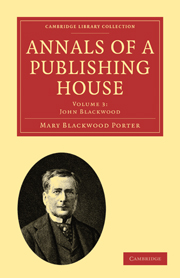Book contents
- Frontmatter
- INTRODUCTION
- Contents
- PLATES
- CHAPTER I EARLY LIFE OF JOHN BLACKWOOD
- CHAPTER II GEORGE ELIOT'S EARLY NOVELS
- CHAPTER III EDINBURGH AND LONDON
- CHAPTER IV A. W. KINGLAKE AND ‘THE INVASION OF THE CRIMEA.’
- CHAPTER V LAURENCE OLIPHANT
- CHAPTER VI THE EDITORIAL SANCTUM
- CHAPTER VII STRATHTYRUM
- CHAPTER VIII CHARLES LEVER
- CHAPTER IX “THE MILITARY STAFF OF BLACKWOOD.”
- CHAPTER X THE EDITOR ABROAD
- CHAPTER XI MRS OLIPHANT AND NEW RECRUITS
- CHAPTER XII GEORGE ELIOT'S LATER WORKS
- CHAPTER XIII LAST YEARS
- INDEX
- Plate section
CHAPTER XII - GEORGE ELIOT'S LATER WORKS
Published online by Cambridge University Press: 05 November 2011
- Frontmatter
- INTRODUCTION
- Contents
- PLATES
- CHAPTER I EARLY LIFE OF JOHN BLACKWOOD
- CHAPTER II GEORGE ELIOT'S EARLY NOVELS
- CHAPTER III EDINBURGH AND LONDON
- CHAPTER IV A. W. KINGLAKE AND ‘THE INVASION OF THE CRIMEA.’
- CHAPTER V LAURENCE OLIPHANT
- CHAPTER VI THE EDITORIAL SANCTUM
- CHAPTER VII STRATHTYRUM
- CHAPTER VIII CHARLES LEVER
- CHAPTER IX “THE MILITARY STAFF OF BLACKWOOD.”
- CHAPTER X THE EDITOR ABROAD
- CHAPTER XI MRS OLIPHANT AND NEW RECRUITS
- CHAPTER XII GEORGE ELIOT'S LATER WORKS
- CHAPTER XIII LAST YEARS
- INDEX
- Plate section
Summary
The story has already been told of George Eliot's introduction to the “House” and John Blackwood's correspondence with her about her first novel, and his pleasure and that of his brother, Major William Blackwood, in her early successes, of which perhaps ‘Adam Bede’ was the most striking. We have now to mark how the years were occupied between the production of ‘Felix Holt’ in 1866 and her last work, ‘Theophrastus Such.’ The intervening years had been fruitful, and her readers found fresh pleasure awaiting them in the poem which forms a sort of halting-ground between her early novels and those which mark the later epoch of ‘Middlemarch’ and ‘Deronda.’ She seems to have paused for a time after leaving the sober everyday pictures of English life with which she had hitherto illustrated her text, and, seizing upon the glowing colours and dramatic possibilities of Spain, she composed a poem on the racial struggles of the Moors and Spanish gipsies. This work, ‘The Spanish Gypsy,’ was published in the spring of 1868, and forms another and striking illustration of her genius. Renunciation is the keynote of this poem, and whatever differences of opinion there may be as to the quality of her verse, there can be no question as to the beauty of thought and poetical feeling that inspired it, while Fedalma, the gipsy heroine, will always rank amongst the most brilliant and tragically interesting of the author's creations.
- Type
- Chapter
- Information
- Annals of a Publishing House , pp. 375 - 399Publisher: Cambridge University PressPrint publication year: 2010First published in: 1898



